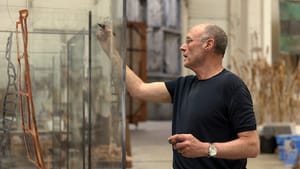Stay in the Loop
BSR publishes on a weekly schedule, with an email newsletter every Wednesday and Thursday morning. There’s no paywall, and subscribing is always free.
When Kiefer met Rodin
Barnes Foundation presents 'Kiefer Rodin' (first review)

You know Auguste Rodin. His sculpture The Thinker has been contemplating the Parkway since 1929. But do you know Anselm Kiefer? The Barnes Foundation newest exhibition, Keifer Rodin, brings you up to speed on both.
To mark the centennial of Rodin’s death, the Barnes collaborated with Paris’s Musée Rodin. Together, they commissioned German artist Anselm Kiefer to create new works inspired by Rodin. The resulting show brings together two great artists separated by a century but united in spirit.
Having purchased a reproduction of Rodin’s erotic aquarelles several years ago in Paris, I know the sculptor’s thoughts of female anatomy were sometimes almost gynecological in nature. The first gallery displays these images as well as assemblages from Rodin’s studio, including small sculptures and molds from previous creations. These represent just a sampling of the artifacts Kiefer discovered during the three years he had access to the storerooms of the Musée Rodin.
Earth and soul
The next gallery contains the showstopper. Les Cathédrales de France (2016), a 12’ x 12’ earth-toned painting by Kiefer, was inspired by the only book ever written by August Rodin — published in 1911 — of the same name. This is Kiefer at his most inventive and ambitious, combining oil, acrylic, emulsion, shellac, and lead on canvas.
The painting’s effect is of decay and rebirth, themes central to Kiefer’s oeuvre. Born in 1945 into the dying embers of Hitler’s Germany, Kiefer creates work that doesn’t shy away from the hard questions. What lasts? What is forgotten?
While this exhibition specifically references Rodin, Kiefer’s previous works have drawn from sources as varied as the Kabbalah and Carl Jung. If you are looking for meaning, Kiefer’s roots run deep.
The same can be said for Rodin (1840-1917). Just take a second look at his Gates of Hell at the Rodin Museum. His gaze went beyond the surface to the inner turmoil of the soul. He chipped away at marble until it revealed agony and joy, tragedy and passion. Kiefer’s work, by contrast, remains more earthbound.
In the third gallery, Kiefer takes Rodin’s erotic imagery to the next level, merging the playful watercolor nudes with massive plaster “books.” This leads to the final and most fascinating gallery and my favorite piece in the show, Untitled (2016), a gigantic egg resting on a rusted scale, suspended from the moon, encased in glass.
I know. It doesn’t make any sense. But, trust me, it’s magical. I was also transfixed by another assemblage-under-glass entitled Die Walkuren, in which articles of clothing appeared to have been dipped in plaster and hung from rusty hangers. What would Rodin say?
To read Pamela Forsythe's review, click here.
What, When, Where
Kiefer Rodin. Through March 12, 2018, at the Barnes Foundation, 2025 Benjamin Franklin Parkway, Philadelphia. (215) 278-7000 or barnesfoundation.org.
Sign up for our newsletter
All of the week's new articles, all in one place. Sign up for the free weekly BSR newsletters, and don't miss a conversation.
 Stacia Friedman
Stacia Friedman